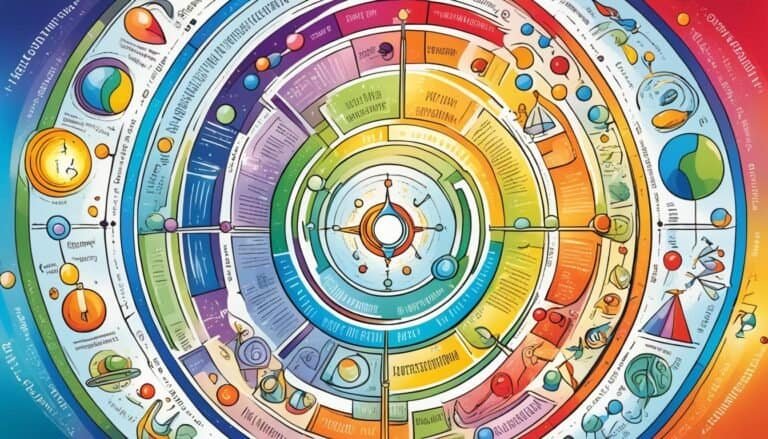Morten Hansen’s Top Lessons for Career Success
“Work smarter, not harder.”
In today’s fast-paced and highly competitive work environment, it is essential to maximize productivity, collaboration, and efficiency. Morten Hansen, renowned researcher and author of “Great at Work,” has dedicated his career to uncovering the strategies and insights that can help individuals excel in their professional lives. Through his extensive research findings and in-depth analysis, Hansen offers valuable lessons on how individuals can navigate their careers effectively and achieve greater success.
Key Takeaways:
- Learn to prioritize high-impact tasks and focus on doing less but obsessing over them.
- Align tasks with personal passion and larger purpose to fuel motivation and engagement.
- Master the art of saying no to low-value tasks to free up time and energy for meaningful work.
- Embrace continuous learning and seek opportunities to develop skills and improve performance.
- Foster collaboration and leverage the diverse strengths and perspectives of team members.
Do Less, Then Obsess
One of the most important lessons from Morten Hansen is the concept of doing less, then obsessing over the selected tasks. In today’s fast-paced work environment, it’s easy to get overwhelmed and spread ourselves too thin. By focusing on fewer tasks and dedicating intense focus and effort to them, we can achieve higher-quality outcomes.
The key to success lies in prioritizing tasks and saying no to low-value activities that only serve as distractions. By consciously selecting high-impact tasks, we free up time and energy to concentrate on the work that truly matters.
“To deliver stellar work, you have to accept the notion that you can’t tackle everything. Instead, be highly selective with your commitments and responsibilities. Combine your narrowed focus with unwavering devotion and passion for each task you undertake.” – Morten Hansen
This approach allows us to allocate our resources effectively and channel our efforts towards producing higher-quality outcomes. By adopting the philosophy of doing less but obsessing over our chosen tasks, we can strive for excellence in our work.
Focus and Effort as Catalysts for Success
When we concentrate our focus and effort on a specific set of tasks, we create an environment conducive to producing outstanding results. By minimizing distractions and eliminating non-essential tasks, we allocate our energy towards achieving a higher level of performance.
This level of dedication ensures that we are fully engaged with the work at hand, allowing us to uncover fresh insights, find innovative solutions, and approach challenges with a heightened sense of creativity. Embracing the mantra of doing less allows us to invest our focus and effort where it truly counts.
| Benefits of Doing Less, Then Obsessing | How to Implement |
|---|---|
|
|
By prioritizing our workload and taking a deliberate approach to our tasks, we can produce work that is more focused, impactful, and of higher quality. Doing less but obsessing over selected tasks is the key to unlocking our true potential and achieving remarkable success.
Mastering Priorities
Hansen’s teachings highlight the critical significance of mastering priorities in achieving success and reaching overall goals. By identifying high-impact tasks that contribute to success, individuals can optimize their productivity and make a substantial impact in the workplace.
Mastering priorities involves skillfully discerning which tasks truly matter and hold the greatest potential for contributing to overall success. By focusing on these tasks, individuals can leverage their time and effort to achieve meaningful outcomes and drive progress.
Identifying high-impact tasks is a fundamental aspect of mastering priorities. It requires assessing the potential value and impact of each task in relation to the overall goals and success of the individual, team, or organization. This assessment enables individuals to prioritize tasks that align closely with the desired outcomes and have the greatest potential for generating impactful results.
Once high-impact tasks are identified, it is crucial to allocate appropriate time and resources to ensure their successful execution. By dedicating focused effort to these tasks, individuals can optimize their productivity and maximize the value they contribute to the overall goals and success of their work.
Benefits of Mastering Priorities
Mastering priorities offers several benefits, allowing individuals to contribute significantly to their overall goals and success:
- Increased Efficiency: By focusing on high-impact tasks, individuals can eliminate time-consuming and low-value activities, freeing up resources to concentrate on what truly matters. This results in improved efficiency and productivity.
- Enhanced Impact: By investing time and effort in tasks that directly contribute to overall success, individuals can make a meaningful impact and drive progress in their work. Each high-impact task completed brings them closer to achieving their goals.
- Aligned Efforts: Mastering priorities facilitates a clear alignment between individual efforts and overall goals. This ensures that the work being done is directly contributing to the success of the individual, team, or organization.
- Greater Control: By successfully identifying and prioritizing high-impact tasks, individuals gain a sense of control over their work. They can proactively navigate their responsibilities, focusing on what matters most and avoiding potential distractions.
To visually illustrate the benefits of mastering priorities, the table below highlights the key advantages and outcomes of this practice:
| Benefits of Mastering Priorities | Outcomes |
|---|---|
| Increased Efficiency | Improved productivity and time management |
| Enhanced Impact | Meaningful contributions towards goals and success |
| Aligned Efforts | Clear connection between individual work and overall objectives |
| Greater Control | Proactive navigation of responsibilities and avoidance of distractions |
Leveraging Passion and Purpose
Aligning tasks with personal passion and a larger purpose can have a profound impact on motivation and engagement in the workplace. When individuals are passionate about their work and understand how it contributes to a greater purpose, it fuels their drive to perform at their best. By leveraging passion and purpose, individuals can enhance their performance, find greater fulfillment, and fuel their motivation.
Aligning tasks with passion and purpose involves identifying the activities and responsibilities that align with one’s interests, values, and goals. When individuals are able to work on tasks that they are truly passionate about, it not only brings them joy but also ignites their enthusiasm and drive. This alignment allows individuals to bring their unique strengths, creativity, and dedication to their work, resulting in higher-quality outcomes.
“Passion is energy. Feel the power that comes from focusing on what excites you.” – Oprah Winfrey
When individuals align their tasks with their passion and purpose, they are more likely to stay motivated, even in the face of challenges or setbacks. The deep connection with their work fuels their determination and perseverance, leading to increased engagement and productivity. Additionally, aligning tasks with a larger purpose allows individuals to see the impact of their work on the organization or society, creating a sense of meaning and fulfillment.
Fueling motivation and engagement
When tasks align with passion and purpose, individuals experience a natural motivation and enthusiasm for their work. They are more likely to proactively seek opportunities for growth, learning, and development within their chosen field. This intrinsic motivation drives individuals to invest their time and effort into honing their skills, expanding their knowledge, and becoming experts in their respective domains.
Moreover, when individuals are engaged in work that aligns with their passion and purpose, they are more likely to demonstrate initiative, creativity, and innovation. They go beyond what is expected of them and strive to make a positive impact. This intrinsic motivation combined with a sense of purpose encourages individuals to take risks, explore new ideas, and contribute to the success of their team or organization.
By leveraging passion and purpose in the workplace, individuals can experience a more fulfilling and rewarding career journey. They find joy and satisfaction in their work, which translates into increased job satisfaction and overall well-being. When individuals are able to align their tasks with their passion and purpose, they not only excel in their work but also find a sense of fulfillment and meaning in what they do.
Learn to Say No
Hansen emphasizes the significance of learning to say no to low-value tasks. Oftentimes, individuals feel compelled to say yes to every request or opportunity that comes their way, fearing that refusing might have negative consequences. However, constantly saying yes leads to spreading oneself too thin and diluting focus and energy on high-value work.
By learning to say no, individuals can free up precious time and energy that can be channeled into tasks that truly add value and contribute to overall success. It’s important to prioritize tasks based on their impact and align them with personal and professional goals. By doing so, individuals can ensure that their efforts are focused on high-value work that drives meaningful results.
The Importance of Saying No to Low-Value Tasks
“Saying yes to everything is like trying to juggle too many balls at once. Eventually, you’ll drop one or more, compromising the quality of your work. Learning to say no is liberating. It allows you to allocate your time and energy to tasks that really matter.”
One of the key benefits of saying no to low-value tasks is the liberation it brings. By declining tasks that don’t align with your goals or contribute to meaningful outcomes, you create space to focus on tasks that truly matter. This increased focus and reduced distraction result in improved productivity and the ability to deliver higher-quality work.
Moreover, by saying no to low-value tasks, you demonstrate your ability to prioritize and make strategic decisions about where to invest your resources. It allows you to assert your boundaries and protect your time and energy. Remember, saying no is not a sign of weakness but a strategic move to maximize your impact and contribution.
Freeing up Time and Energy
Learning to say no not only frees up time but also conserves valuable energy. By decluttering your task list and selectively committing to high-value work, you prevent burnout and maintain a healthy work-life balance. This, in turn, increases job satisfaction and overall well-being.
When you say no to low-value tasks, you create a positive loop of energy conservation. By avoiding unnecessary commitments, you have more time and energy to invest in tasks that truly align with your passions and goals. This fuels your motivation, enhances your focus, and allows you to consistently deliver your best work.
Ultimately, learning to say no is a skill worth mastering. By prioritizing and selectively choosing where to invest your time and energy, you can release the burden of low-value tasks and unlock your full potential to achieve career success.
Embrace Continuous Learning
In the fast-paced and ever-evolving professional world, embracing continuous learning is key to staying relevant and thriving in your career. Morten Hansen’s research and insights highlight the importance of cultivating a growth mindset and actively seeking opportunities to learn, develop skills, and improve performance. By prioritizing continuous learning, individuals can adapt to changing circumstances, acquire new knowledge, and excel in their work.
A growth mindset is the foundation of embracing continuous learning. It involves believing that abilities and intelligence can be developed through dedication and hard work. Cultivating a growth mindset allows individuals to view challenges as opportunities for growth, persist in the face of setbacks, and seek feedback for improvement.
“The journey of continuous learning begins with adopting a growth mindset that fuels curiosity, resilience, and a hunger for improvement.”
Seeking opportunities to learn and improve is a proactive approach to personal and professional development. It involves exploring new areas of interest, attending relevant workshops or conferences, and taking on challenging assignments. By seeking out these opportunities, individuals expand their knowledge base, enhance their skill set, and discover new ways to contribute to their organizations.
One effective way to embrace continuous learning is by joining professional networks or communities that encourage knowledge sharing and collaboration. Engaging with like-minded professionals allows for the exchange of ideas, best practices, and insights from diverse perspectives. This collaborative environment fosters a culture of continuous learning, where individuals can grow and learn from each other.
Benefits of Embracing Continuous Learning:
- Enhanced Adaptability: Continuous learning equips individuals with the skills and knowledge needed to adapt to rapidly changing environments and technologies.
- Improved Performance: Acquiring new knowledge and skills enhances performance, productivity, and the ability to deliver high-quality results.
- Career Advancement: Continuous learning demonstrates a commitment to professional growth, making individuals more competitive in the job market and opening doors to new opportunities.
- Increased Job Satisfaction: Engaging in ongoing learning and skill development fosters a sense of fulfillment and personal growth, leading to higher job satisfaction.
Embracing continuous learning is a lifelong journey that requires dedication and a proactive approach. By cultivating a growth mindset, seeking opportunities to learn and improve, and engaging with a network of professionals, individuals can stay ahead of the curve, adapt to changing demands, and achieve greater success in their careers.
Foster Collaboration
Collaboration and teamwork play a vital role in achieving greater results in the workplace. Morten Hansen emphasizes the importance of fostering collaboration as it allows organizations to leverage the diverse strengths and perspectives of team members. By working together effectively, individuals can accomplish more than they could on their own and drive success for the entire team or organization.
Collaboration enables the pooling of knowledge, skills, and resources, leading to innovative solutions and improved outcomes. When team members collaborate, they bring their unique expertise and experiences to the table, enhancing problem-solving capabilities and fostering creativity. By combining different perspectives and ideas, teams can generate more comprehensive and well-rounded solutions to complex challenges.
“Collaboration allows us to tap into the collective intelligence of a group and harness the power of synergy, resulting in outcomes that are greater than the sum of their parts.”
Furthermore, collaboration promotes a sense of belonging and shared ownership among team members. When individuals feel included and valued within a collaborative environment, they are more motivated to contribute their best work and actively engage in the team’s success. This sense of belonging creates a positive and supportive work culture, fostering a greater sense of camaraderie and cohesion within the team.
Collaboration also enables the development of strong interpersonal relationships and effective communication. When team members collaborate, they have the opportunity to build trust, enhance their understanding of each other’s strengths and limitations, and establish open lines of communication. This foundation of trust and effective communication allows for smoother workflow, improved coordination, and faster problem resolution.
Overall, fostering collaboration within organizations is crucial for achieving greater results. By encouraging teamwork, organizations can tap into the collective intelligence and diverse perspectives of their team members, leading to more innovative solutions, increased productivity, and overall success.
Benefits of fostering collaboration:
- Enhanced problem-solving capabilities and creativity
- Improved outcomes through the pooling of knowledge and resources
- Increased motivation and engagement
- A positive and supportive work culture
- Stronger interpersonal relationships and effective communication
Focus on Value Addition
To achieve success in your career, it is essential to focus on tasks that directly contribute to the organizational goals and outcomes. Prioritizing value-added tasks allows individuals to maximize their contribution and impact on overall success. It involves discerning which tasks are truly essential and aligning efforts accordingly.
“The key to achieving career success is not just about working hard, but working smart by focusing on tasks that add value to your organization or team,” asserts Morten Hansen.
By prioritizing tasks that add value, you can ensure that your efforts are directed towards activities that contribute to the organization’s strategic objectives. This may involve identifying initiatives that align with critical business priorities, projects that drive revenue growth, or tasks that enhance operational efficiency.
Moreover, focusing on value addition allows individuals to differentiate themselves and showcase the impact they bring to the organization. It demonstrates a proactive approach to personal and professional development, highlighting the ability to contribute meaningfully to organizational goals.
To effectively focus on value addition, consider the following strategies:
- Regularly assess the impact of your tasks: Reflect on the outcomes or results of your work and evaluate how they contribute to the organization’s success. Identify tasks that may be taking up unnecessary time and effort without significant value.
- Align tasks with organizational goals: Understand the broader objectives of your organization and align your tasks to support these goals. This ensures that your work directly contributes to driving the organization forward.
- Collaborate with stakeholders: Engage with stakeholders to gain a deeper understanding of their needs and expectations. By actively seeking feedback and understanding their priorities, you can focus on tasks that are most valuable to them.
- Continuously educate yourself: Stay updated on industry trends, technological advancements, and best practices to identify new opportunities for value addition. This includes seeking professional development opportunities and actively learning from others.
Examples of Value-Added Tasks
| Industry | Value-Added Task |
|---|---|
| Marketing | Developing targeted campaigns to reach specific customer segments and drive conversion |
| Finance | Analyzing financial data to identify cost-saving opportunities and improve financial performance |
| Sales | Buidling strategic partnerships with key clients to drive long-term revenue growth |
| Operations | Streamlining processes to optimize efficiency and reduce operational costs |
By focusing on tasks that add value and contribute to the organization’s goals, you can position yourself as a valuable asset and increase your chances of career success. Prioritize your efforts, collaborate effectively, and continuously seek opportunities to enhance your contribution. Remember, it’s not just about being busy, but about making a meaningful impact on the organization’s success.
Manage Energy, Not Time
In the pursuit of productivity and peak performance, many individuals focus primarily on managing their time. However, Morten Hansen challenges this conventional notion and suggests that managing energy is actually the key to unlocking your full potential.
When we optimize our energy levels, we can sustain our productivity over the long term and achieve peak performance in our work. This involves prioritizing self-care, rest, and exercise to replenish our energy reserves and maintain our mental and physical well-being.
“The key to peak performance is not time management, but rather energy management. By taking care of our energy levels, we can bring our best selves to our work and accomplish more than we ever thought possible.”
To manage energy effectively, it’s important to establish healthy habits that support our physical and mental vitality. This can include setting boundaries to protect our personal time, engaging in activities that bring us joy, and practicing mindfulness or meditation to enhance focus and reduce stress.
By taking a proactive approach to energy management, we can avoid burnout and achieve sustainable success. It’s not about working longer hours or pushing ourselves to the limit but rather finding a balance that allows us to thrive both personally and professionally.
Optimizing Energy Levels
To optimize your energy levels, consider the following strategies:
- Rest: Prioritize quality sleep and ensure you get adequate rest throughout the day to recharge your mind and body.
- Exercise: Incorporate regular physical activity into your routine to boost energy levels, improve focus, and reduce stress.
- Self-Care: Dedicate time to activities that nourish your soul and bring you joy, such as hobbies, spending time with loved ones, or practicing self-reflection.
- Healthy Diet: Fuel your body with nutritious foods that provide sustained energy and support overall well-being.
- Stress Management: Find healthy ways to cope with stress, such as deep breathing exercises, meditation, or engaging in activities that help you unwind.
The Power of Managing Energy
By prioritizing energy management, individuals can experience a range of benefits that contribute to their overall well-being and performance:
| Benefits of Managing Energy | |
|---|---|
| Enhanced Focus: | Optimizing energy levels allows you to maintain focus and concentration, leading to higher-quality work and improved productivity. |
| Increased Resilience: | Managing energy helps build resilience, enabling individuals to bounce back from setbacks and tackle challenges with a renewed sense of determination. |
| Improved Decision-Making: | When your energy levels are optimized, you are better equipped to make sound decisions and evaluate options more effectively. |
| Enhanced Well-Being: | By nurturing your energy levels, you can experience improved overall well-being, including better physical health and reduced stress. |
So, instead of solely focusing on managing time, shift your perspective and prioritize energy management. By optimizing your energy levels through effective rest, exercise, and self-care, you can achieve peak performance and sustain your productivity for the long haul.
Feedback and Adaptation
Hansen highlights the importance of feedback in the pursuit of continuous improvement. Embracing feedback and using it to adapt and refine one’s performance is crucial for growth and success. By being open to feedback, individuals can identify areas for improvement and make the necessary adjustments to enhance their performance.
Constructive feedback provides valuable insights into our strengths and areas that require development. It allows us to gain a fresh perspective and uncover blind spots that may hinder our progress. By embracing feedback, we open ourselves up to opportunities for growth and improvement.
Feedback also plays a vital role in fostering collaboration and teamwork. When we receive feedback from our colleagues and teammates, it creates an environment of trust and open communication. It helps us understand how our actions and behaviors impact those around us, enabling us to work together more effectively towards shared goals.
Continuous improvement is a fundamental aspect of personal and professional growth. Through feedback, we can identify areas where we can enhance our skills, knowledge, and performance. It provides us with valuable insights into how we can refine our processes, optimize our strategies, and deliver better results.
Feedback is not about pointing out flaws or shortcomings; it is a tool for growth and development. Embrace feedback as an opportunity to learn, adapt, and continuously improve.
Adaptation is the process of adjusting and modifying our approach based on the feedback we receive. It involves being open-minded, flexible, and willing to make necessary changes to achieve better outcomes. By actively incorporating feedback into our workflow, we can refine our methods, learn from our mistakes, and make continuous progress.
The Benefits of Embracing Feedback and Continuous Improvement:
- Enhanced personal and professional growth
- Improved collaboration and teamwork
- Increased self-awareness and self-development
- Efficient and effective problem-solving
- Adaptability to changing circumstances
By embracing feedback and continuously striving for improvement, we can unlock our full potential and achieve greater success in our careers and personal lives.
Conclusion
In conclusion, Morten Hansen’s research and insights provide valuable lessons for achieving career success. By implementing the key strategies highlighted in Hansen’s work, individuals can work smarter, enhance collaboration, and boost their overall productivity.
Hansen’s emphasis on focusing on fewer tasks and obsessing over them allows individuals to prioritize high-impact work and achieve higher-quality outcomes. By mastering priorities and aligning tasks with personal passion and purpose, individuals can find greater motivation and engagement in their work.
Continuous learning and embracing feedback are also vital for growth and improvement. By seeking opportunities to learn and adapt, individuals can stay ahead in a rapidly changing work environment and continuously enhance their performance. Fostering collaboration and managing energy effectively further contribute to achieving career success.
By applying these lessons from Morten Hansen, individuals can develop key strategies for career success and strive towards achieving their professional goals.








